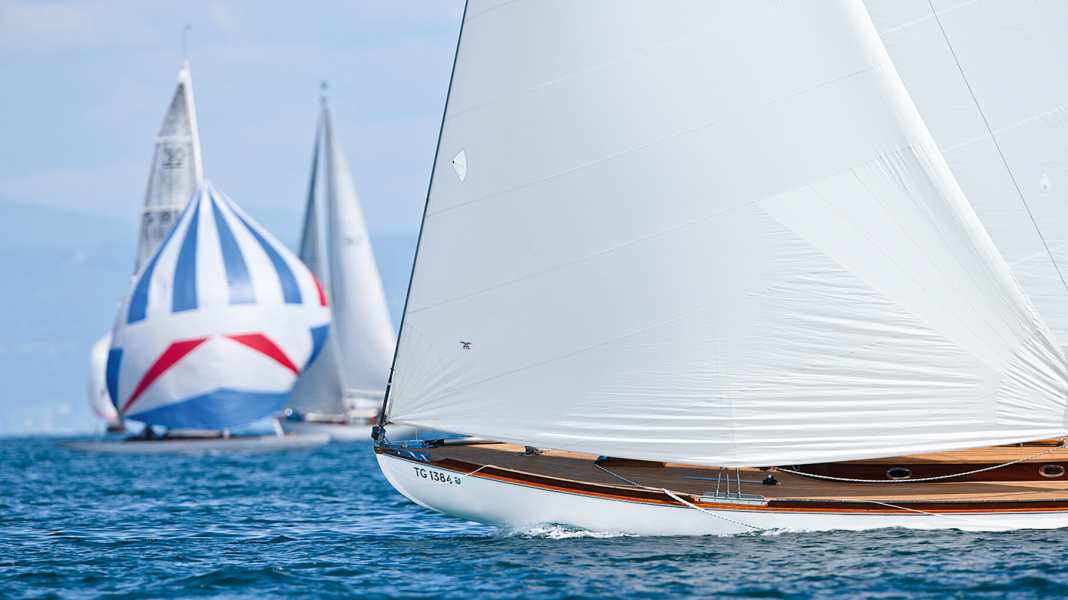
The headsail, whether jib or genoa, is the main propulsion of a yacht when sailing downwind and acts as an aerofoil that generates the necessary pressure difference and enables propulsion. This results from the more favourable angle of attack compared to the mainsail and the interaction of both sail profiles. Similar to a trim tab on an aerofoil, the mainsail serves to influence the flow around the headsail and only makes a minor contribution to propulsion itself.
The parts in this sail trim special:
Put simply, the main shovels air that would actually flow past the genoa upwind around its luff to leeward, which additionally increases the negative pressure there. This is why it is even more important to trim the genoa correctly than the mainsail.
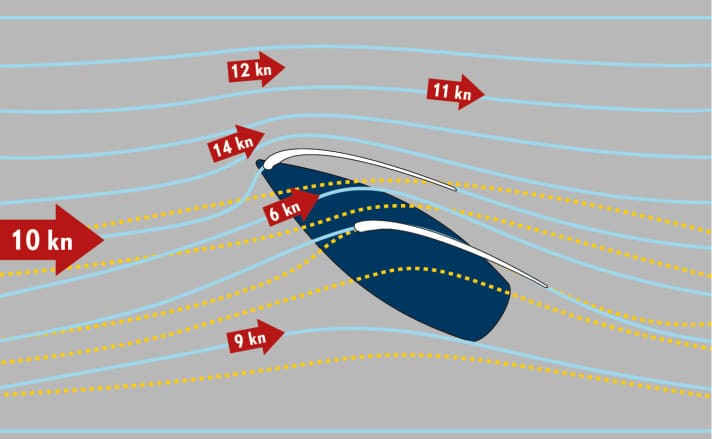
Incorrect genoa trim settings can not only cost a lot of speed, but also make sailing much more difficult. A correctly adjusted headsail can calm the yacht's movements, especially on upwind courses, but can also reduce heeling and windward yaw. The former is a clear gain in comfort for the crew, the latter is easier on the helmsman's arm or the autopilot mechanism.
But although genoa trim is so important, the genoa is usually more difficult to adjust than the mainsail. This is due to the different way the two sails are rigged. The mast offers the mainsail a much more calculable, controllable hold than the genoa forestay. In addition, the main boom, as the spreader of the clew, allows large changes in the angle of attack without losing the profile. Important: Not all headsails are the same. The cut, size and, above all, a furling system must be taken into account.
Rolling genoas are comfortable - at the expense of the profile
Because only very elaborately manufactured genoas, with furling reinforcements and made of robust material, hold their profile halfway when furled. This is because it cannot actually work to wind a double-curved surface, which is what a sail is, onto a rigid axle. This often causes the belly to shift aft and the profile to deepen. The older the sail, the more pronounced this effect usually is. In the worst case, there is only a bag hanging from the forestay, which generates too much pressure, and this is also quite high up in the rig, where it is of least use.
However, this should No general plea The ease of handling is an unbeatable argument against furling genoas for cruising sailors. However, when the wind picks up, you should be aware of their weaknesses when reefed. Trimming measures can only help to a limited extent. This is why the principle also applies to furling genoas: trim before reefing.
So how does the perfect genoa trim work? There is no one-size-fits-all answer to this question. It depends too much on the characteristics of the yacht, its weight and ballast, its sail area and its distribution. Despite the sometimes significant differences, there are also various trim options that are available on almost every yacht. These include the genoa halyard and backstay, the mainsheet and the adjustability of the centre of gravity. The effects they have on the triangular cloth are explained in detail on the following pages.
Setting the lifting point in the longitudinal direction
The hole point position in the longitudinal direction influences the tread depth and twist
Each genoa has its own hoisting point position. This determines how much of the sheet's pull is distributed between the foot and the leech. The following rule of thumb is suitable for the basic setting: The direction of the sheet pull should be the extension of a straight line that runs from the centre of the luff over the clew.
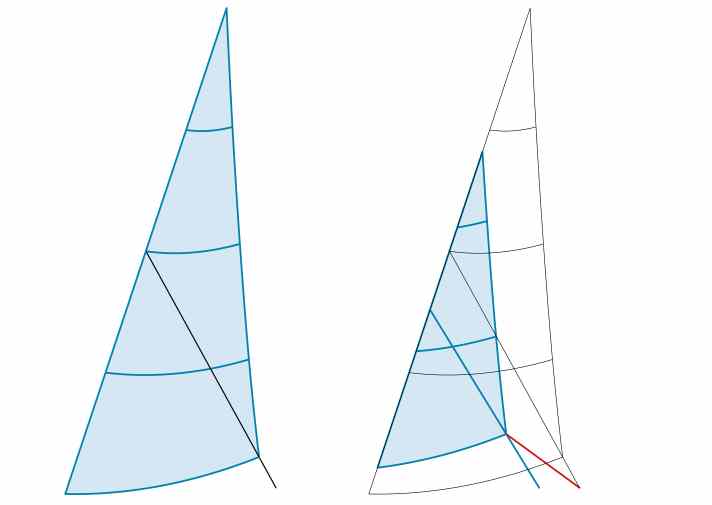
Wind straps are essential for further adjustment. At least three pairs should be evenly distributed behind the luff. The position of the hoist point is correct when all three windward tethers lift off at the same time when slowly tacking upwind on a course. The twist of the genoa can now be changed by shifting the centre of lift lengthways. At the same time, the profile depth is adjusted.
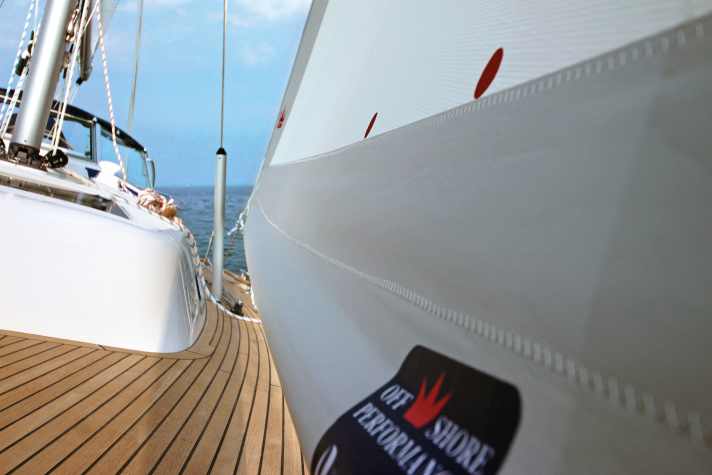
Shifting the centre of lift forwards increases the tension on the leech, which closes more. The lower leech is relieved and the distance between the clew and luff is reduced. This makes the profile rounder and deeper and generates more pressure, which can be an advantage in medium winds and choppy seas or on heavy yachts. However, some height is lost upwind. The hoisting point is too far forwards when the leeward line lifts off the top pair of wind tapes. The current then breaks off there due to the strong rounding of the profile.
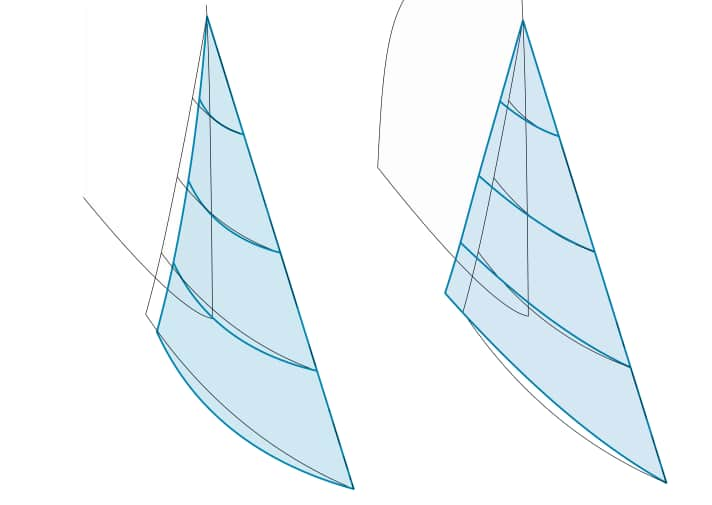
If the pressure in the headsail becomes too great as the wind increases, which is noticeable through heeling and increasing windward yaw, a first measure before reefing is to shift the centre of gravity aft. This causes the genoa to open the leech in the upper area, releasing pressure where it contributes most to windward leeway. At the same time, the profile is flattened, which in turn reduces pressure. And the flat leading edge allows a little more height to be sailed.
Correct sheet tension
The genoa sheet is the most important trimming device for the headsail
The sheet can also be used to correct the profile depth and the twist of the genoa, but with different dependencies than with the centre of gravity adjustment.
Fastening the mainsheet
When the genoa sheet is lowered, the distance between the clew and the head and neck of the sail is reduced. The leech opens more and at the same time the profile becomes deeper. The angle of attack increases slightly. This means that the sheet is slightly feathered when more pressure is required, for example when starting off after a tack or in short, steep seas. In other words, whenever a lot of horsepower is needed from the headsail.
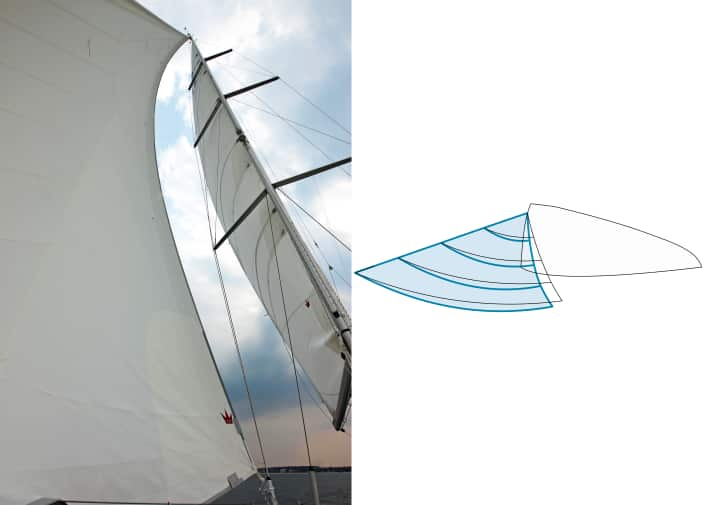
Tighten sheet
The effect is reversed when the wing is tightened. The angle of attack becomes smaller, the profile flatter and aft more closed. More height can be travelled, for example in shallow water. If the sail develops too much pressure, shifting the centre of gravity aft can help. The best way to check the sheet tension is to look at the leech, for example at the position of the spreaders. These should have markings.
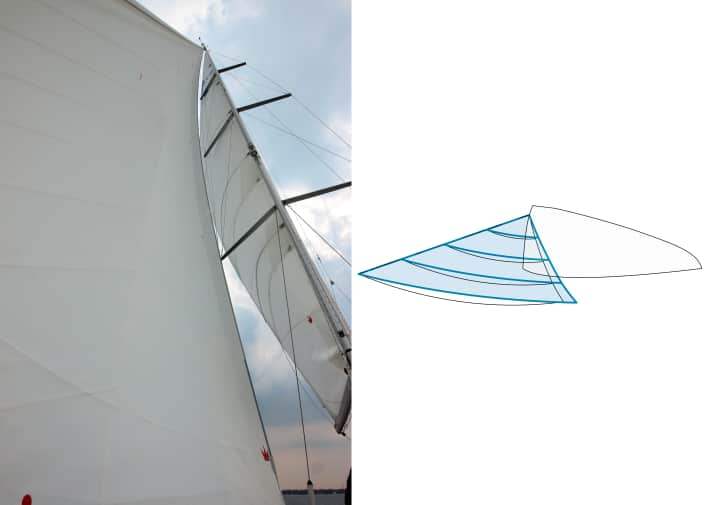
Setting the drop voltage
The position of the profile in the longitudinal direction affects the steering feel
As the wind increases, the belly of the genoa shifts aft. The halyard's sag counteracts this. This can achieve a lot, especially with older, baggy sails. However, as soon as a vertical crease forms on the luff, there is too much tension on the halyard. Modern laminate sails react less to this trimming device. With them, only creases should be removed. The backstay can also take over the profile shift.
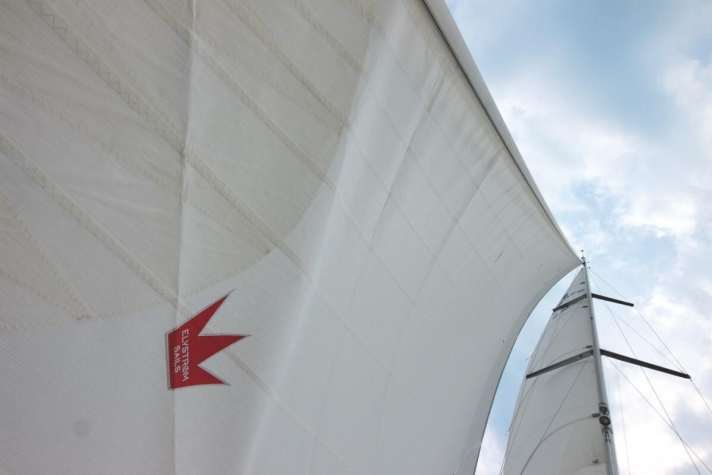
In some regatta classes, even with more wind, less halyard tension is used, but a lot of backstay. This keeps the leading edge of the genoa flat and no height is lost.
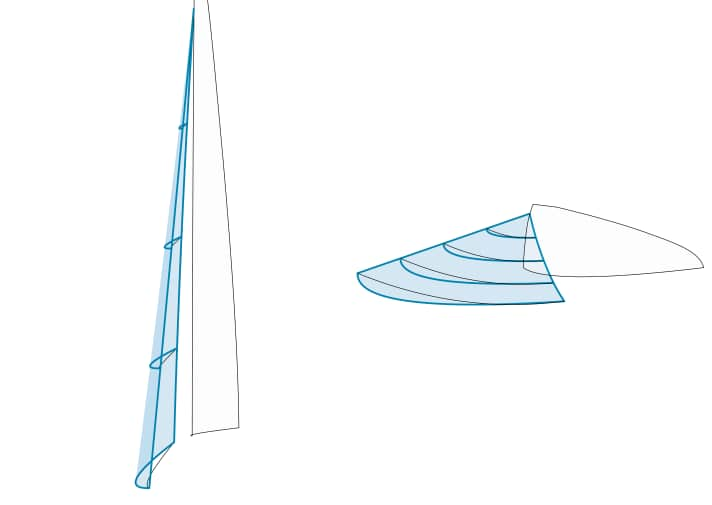
Hole point adjustment transverse
By changing the position, the angle of attack on the wind can be reduced and the excessive twist when rising and falling can be minimised
The more stretched (narrower) the genoa is, the more the leech opens when the sheet is lowered. This is most obvious with self-tacking jibs. Even a small shift can be enough for the upper third to turn away without any effect. This can be remedied by shifting the centre of the hull outwards. A snatch block can be attached to the sheet and then to the foot rail.
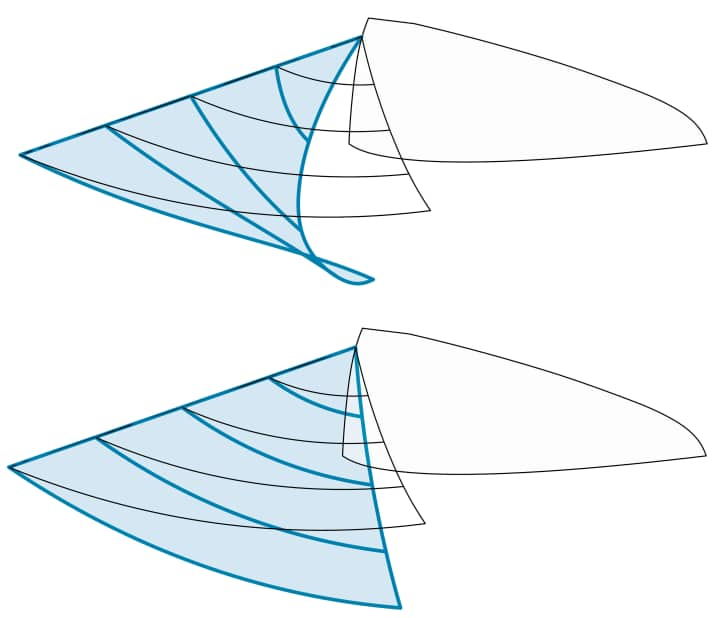
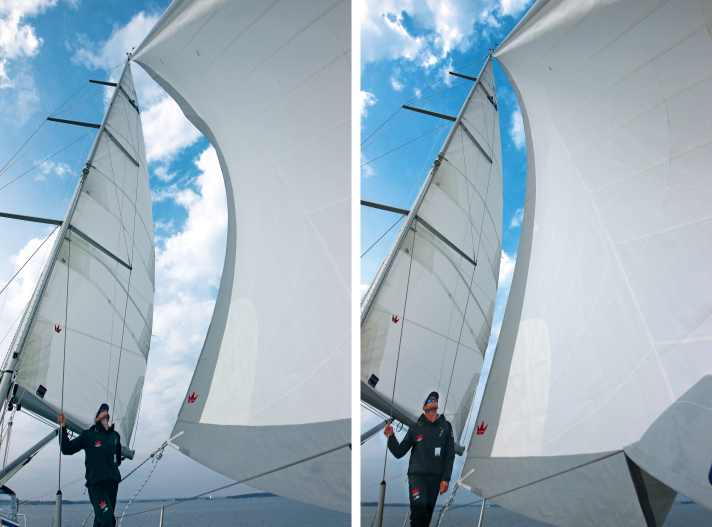
The hoisting point can be shifted inwards for better height upwind. With only slightly overlapping genoas, this often works by additionally tightening the windward sheet. This reduces the angle of attack. However, propulsion is also lost, which is why this trimming measure often only brings advantages in smooth water when little pressure is required.

Genoa trim via the backstay
Depending on the rig type, backstay trim is an aid to control the position of the maximum profile depth and the twist
A high forestay tension is always desirable in medium winds. In light winds, a slightly sagging forestay can bring advantages, as the distance between the luff and leech is shortened, the profile becomes rounder, especially in the upper to middle range, and generates more pressure. At the same time, however, height is lost downwind. A taut forestay is desirable as soon as pressure needs to be released, for example when the sail is too greedy upwind. It brings the leading edge as far to windward as possible and also opens the genoa slightly at the top.
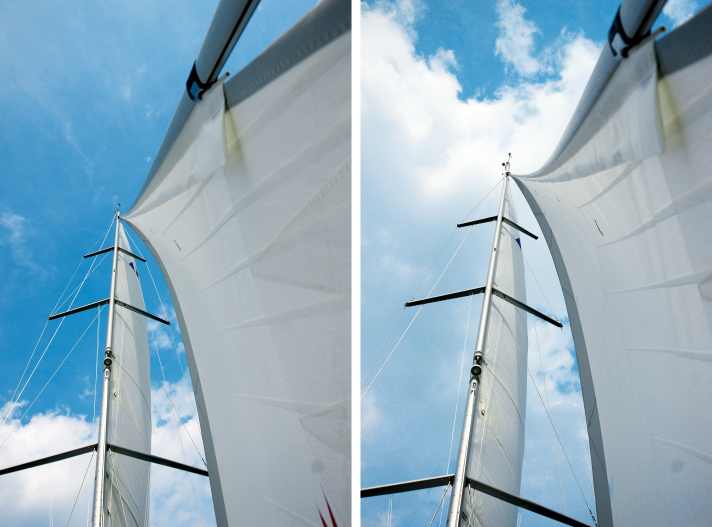
With top-rigged rigs, the forestay tension can be increased by pushing through the backstay. With fractional rigs, backstays are used for this purpose. This is somewhat more difficult with fractional rigs with swept spreaders without backstays, only with backstays. Here, part of the pulling force goes into bending the mast and, depending on the number and tension of the lower shrouds, can have the opposite effect. This is because the bending also compresses the mast, the distance to the deck is reduced slightly and the forestay tension decreases.
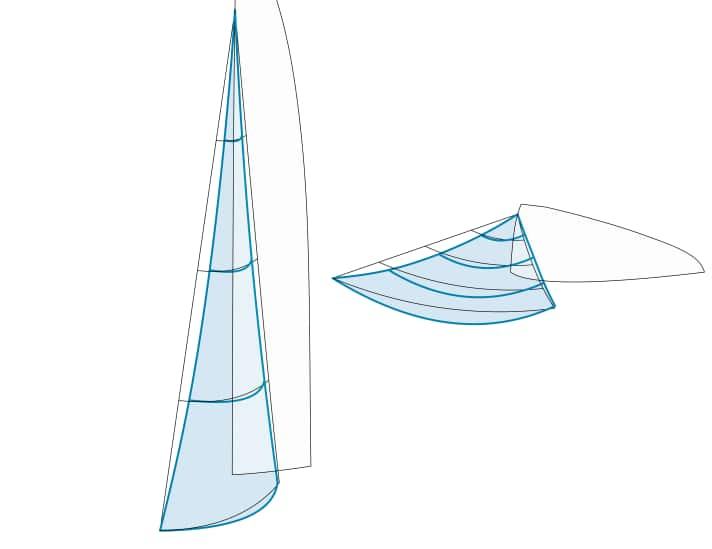
Genoa trim in video
The following YACHT-TV report shows what the different sail positions look like on the water and how changes affect the profile:

